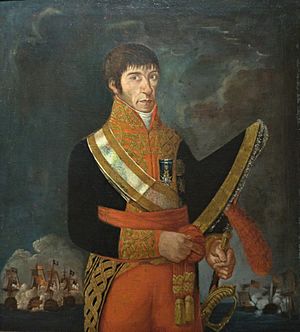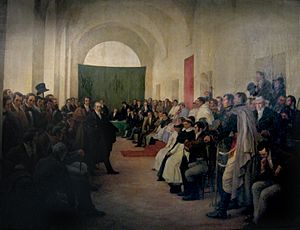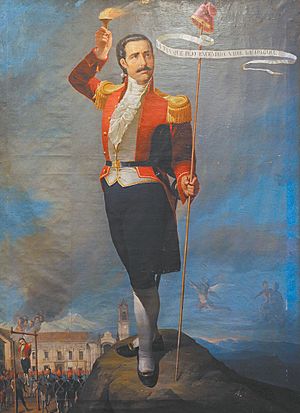Baltasar Hidalgo de Cisneros facts for kids
Quick facts for kids
Baltasar Hidalgo de Cisneros
|
|
|---|---|

Portrait of Baltasar Hidalgo de Cisneros
|
|
| 11th Viceroy of Río de la Plata | |
| In office 15 July 1809 – 25 May 1810 |
|
| Monarch | Junta of Seville |
| Preceded by | Santiago de Liniers |
| Succeeded by | Francisco Javier de Elío |
| Personal details | |
| Born | 6 January 1756 Cartagena, Spain |
| Died | 9 June 1829 (aged 73) Cartagena, Spain |
| Nationality | |
| Political party | Royalist |
| Spouse | Inés de Gaztambide |
| Military service | |
| Allegiance | Spain |
| Years of service | 1770-1805 |
| Rank | Admiral |
| Commands | San Pablo, Nuestra Señora de la Santísima Trinidad |
| Battles/wars | Battle of Cape St Vincent, Battle of Trafalgar |
Baltasar Hidalgo de Cisneros (born January 6, 1756 – died June 9, 1829) was an important Spanish naval officer. He was born in Cartagena. He fought in big sea battles like the Battle of Cape St Vincent and the Battle of Trafalgar. He also helped Spain fight against Napoleon's invasion in 1808.
Later, he became the Viceroy of the Viceroyalty of the Río de la Plata. This was a large Spanish colony in South America. He took over from Santiago de Liniers. During his time as Viceroy, he faced several local uprisings. He was eventually removed from power during the May Revolution in 1810. He tried to stay in charge but was forced to resign. After this, he was sent back to Spain, where he died in 1829.
Contents
Who Was Baltasar Hidalgo de Cisneros?
Baltasar Hidalgo de Cisneros was born on January 6, 1756. This day is a religious holiday called Epiphany. Because of this, he was named Baltasar, like one of the Three Wise Men. His father, Francisco Hidalgo de Cisneros y Seijas, was also a naval officer.
Baltasar began his career in the navy in 1770. He traveled to the coasts of Africa and Peru. He also took part in a military campaign in Algiers. He helped capture an enemy ship in the English Channel. This led to him being promoted to ship's lieutenant. In 1795, he became the commander of a ship called the San Pablo. This ship was part of the Spanish fleet.
Fighting in Big Sea Battles
Spain was fighting the Anglo-Spanish War at this time. Baltasar's fleet fought a smaller British fleet. They were defeated in the Battle of Cape St Vincent.
In 1803, he was in charge of the naval base in his hometown of Cartagena. In 1805, he was the captain of Spain's largest ship, the Nuestra Señora de la Santísima Trinidad. This was during the famous Battle of Trafalgar. This battle was a major victory for the British navy.
During the battle, a mast from his ship fell and hit Baltasar on the head. This caused a serious injury. It left him partially deaf for the rest of his life. After this, people nicknamed him "El sordo", which means "The deaf one" in Spanish. His ship was captured by the British but sank the next day. Cisneros was taken prisoner and received medical care. Even as a prisoner, he was honored for his bravery. When he returned to Spain, he was promoted to lieutenant general.
Becoming a Viceroy
After recovering from his injuries, Cisneros received more promotions. He served as a leader in the governing council of Cartagena. Later, the main Spanish government in Seville decided to deal with problems in the Viceroyalty of the Río de la Plata. They sent Cisneros to replace the current Viceroy, Santiago de Liniers. The government thought Liniers might be disloyal to Spain.
Cisneros was ordered to land in Montevideo. He was told to gather armies against Liniers and send him back to Spain. He was also told to get rid of the local armies made up of people born in the colonies. The Spanish government also wanted him to find and punish anyone who supported Napoleon.
Cisneros arrived in Montevideo in June 1809. Some people, like Manuel Belgrano, wanted Liniers to fight against being removed. But Liniers chose to give up his power peacefully to Cisneros. Cisneros realized that Liniers was not a rebel. So, he allowed Liniers to stay in the colony. The local leader in Montevideo, Javier de Elío, also accepted Cisneros's authority.
Cisneros's Time as Viceroy
Cisneros tried to make peace between different political groups. He allowed the local armies to stay. He also gave their commanders special status, which was usually only for Spanish military officers. He also pardoned some people who had rebelled earlier.
He tried to improve trade by allowing more free trade. But local shopkeepers forced him to bring back the old trade rules. A lawyer named Mariano Moreno wrote a document asking Cisneros to reopen free trade. This document was very important for the economy at the time. Cisneros finally allowed free trade for a limited time.
In 1809, there were two important uprisings in the colony. One happened in Chuquisaca and another in La Paz. These rebellions wanted more local control. Spanish officials quickly put down these rebellions. Armies from Buenos Aires and Lima defeated the rebels. Some leaders, like Pedro Domingo Murillo, were executed. These harsh actions made the local people, called Criollos, feel even more unfairly treated. This made them more angry at the Spanish rulers.
In November 1809, Cisneros created a special court. Its job was to find and punish anyone who supported "French ideas" or wanted to create new governments against Spain. However, he refused a suggestion to banish many people who were seen as dangerous to Spanish rule. These people included important figures like Saavedra, Moreno, and Belgrano. Cisneros also tried to stop the spread of news that he thought might cause trouble. These actions made the Criollos feel that a revolution was coming.
The May Revolution

In May 1810, news reached Buenos Aires that the main Spanish government had fallen. With no king or main government in Spain, many people believed Cisneros no longer had the right to rule. This started the May Revolution. Cisneros tried to calm the people, but it didn't work. He asked the army commanders for support, but they refused.
Cisneros was forced to allow a special public meeting called an open cabildo. This meeting would decide what to do next. Usually, only the richest people attended these meetings. But the army and a group of angry citizens made sure that many ordinary people could attend instead.
The open cabildo decided that Cisneros should no longer be Viceroy. They wanted to create a new government council. However, the city council tried to trick the people. They appointed Cisneros as the president of the new council. This meant he would still be in power, just with a different title.
The new council took an oath, but the people were still very angry. By the end of the day, the council members resigned, and Cisneros resigned too. The city council first refused his resignation. But the public anger was so strong that the council itself was partly taken over by the people. Cisneros's resignation was finally accepted. A new government, called the Primera Junta, was then formed with members chosen by the people. After losing his power, Cisneros sent a message to the former viceroy, Liniers, asking him to gather an army and fight the new government.
Return to Spain
After being removed from power, Cisneros became a regular citizen in Buenos Aires. The new government was supposed to protect him. However, the new government did not trust him. So, he was sent away to the Canary Islands. Other Spanish officials were also sent with him. The reason given was that his life was in danger.
His wife, Inés de Gaztambide, stayed in Buenos Aires for a while. But she later moved to Montevideo. Montevideo was a city that did not support the new government in Buenos Aires. They welcomed her like a queen. The attempt by Liniers to fight the new government failed completely. Liniers was captured and executed.
Once in Spain, Cisneros went to Cádiz. He had to go through a review of his time as Viceroy. The government found no problems with his rule. He was even promoted to general captain of Cádiz. He was put in jail during an uprising in Spain but was freed when King Ferdinand VII returned. In 1823, he was made general captain of his home city of Cartagena. He died there in 1829.
Images for kids
See also
 In Spanish: Baltasar Hidalgo de Cisneros para niños
In Spanish: Baltasar Hidalgo de Cisneros para niños



